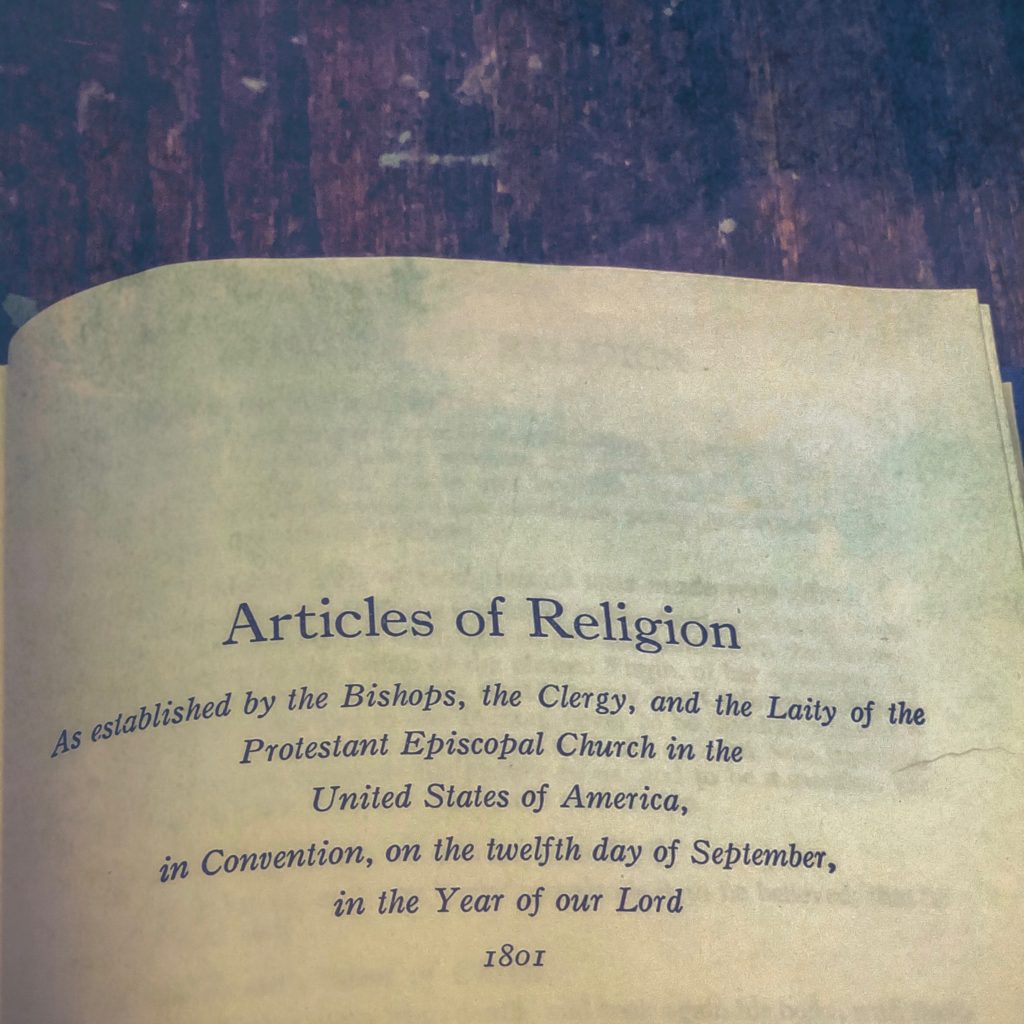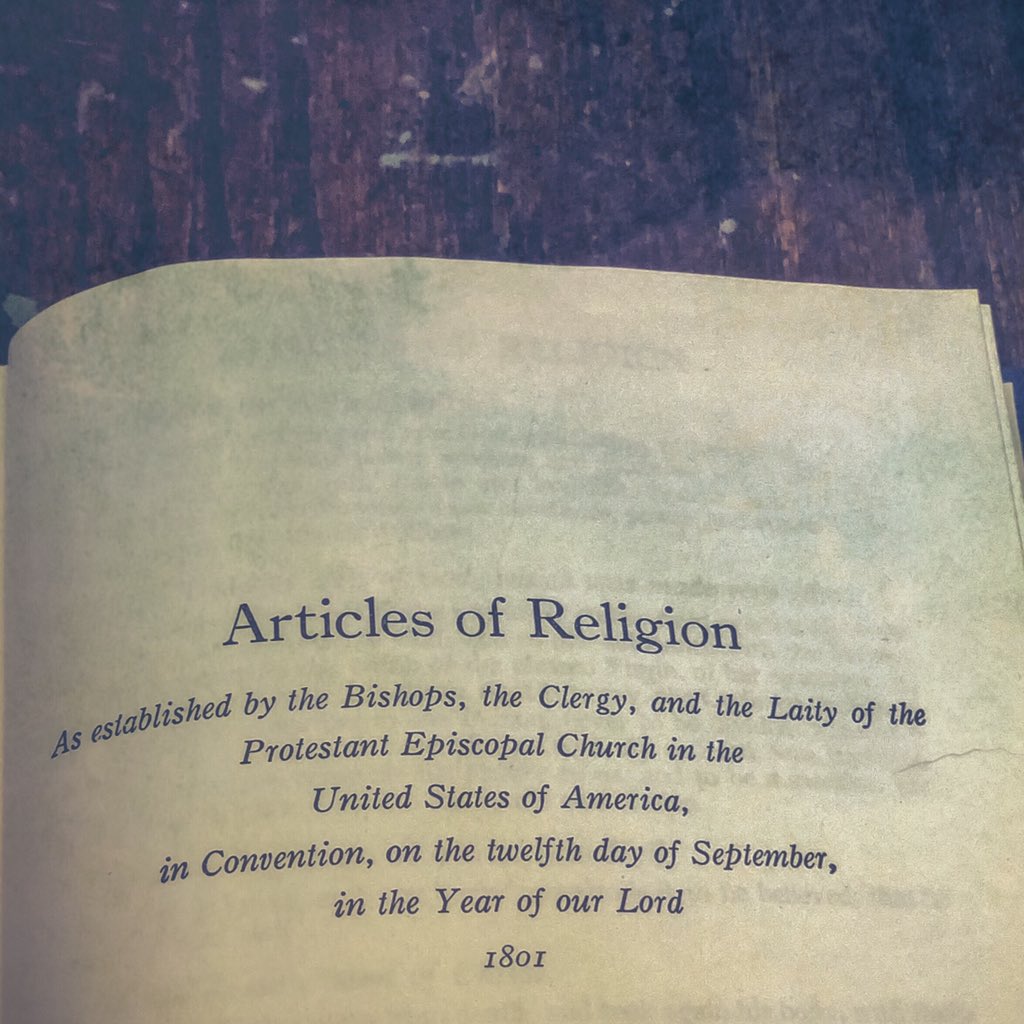
by the Rev. K. Nicholas Forti
The second article addresses the Incarnation of God the Son—the Person and Work of Jesus Christ. In this way, it follows doctrinally from the first article, which dealt with the nature of the one God, the divine attributes and perfections, as well as the tri-unity of the hypostases or persons—Father, Son, and Holy Ghost. Just as the first article recapitulated the truths of the Nicene Creed (BCP 326-328) and the Apostles’ Creed (BCP 53 & 96), as well as the Athanasian Creed (BCP 864-865), the second article summarizes and echoes the Chalcedonian Definition (BCP 864).
Looking back over nearly five hundred years, this way of beginning the Confessional Statement of Anglicanism may not seem particularly noteworthy to us. At the time, however, it was deliberate and distinctive. This can be seen by a comparison of the Articles with the Second Helvetic Confession (1566) and the Westminster Confession (1646). Both of these prominent Reformed confessions begin with the doctrine of Scripture as the means by which knowledge of saving faith can be obtained. These confessions—and the Reformed tradition—anticipated the modern turn to the subject and epistemology because their starting point includes as implicature the human subject as knower and how she knows of God—(see Calvin’s Institutes).
It should come as no surprise that the Reformed tradition was already making the move to establish as foundational the human subject as knower even before the ascendancy of Cartesian and Kantian philosophies. The groundwork of those philosophies was laid by the humanism of the Renaissance. The Reformed tradition largely emerged out of that very same humanism and savored more fully of it than either Lutheranism or Anglicanism did. Recall that the founder of the Reformed tradition, Huldrych Zwingli (1484-1531) claimed to have hit upon the primary insights of the Reformation independently of Martin Luther (1483-1546). This bold claim has been deemed incredible by some historians; however, it seems less outrageous when we remember that both Zwingli and Luther were deeply influenced by the humanism of their day and in similar contexts. Still, the debates that raged between Zwingli and Luther suggest that they didn’t entirely agree on what those primary insights of the Reformation were—or, at least, how they were to be understood.
The crucial divide between the two reformers was over the presence of Christ in the Eucharist—a debate which came to a head at the Colloquy of Marburg in 1529. Fifteen articles had been drawn up to establish the cooperation of the two primary leaders of the Reformation and the unity of the Reformation as a whole. Luther and Zwingli were able to agree on all but one of those articles, the one concerning the Eucharist. However, it’s instructive to note that there were, among the Marburg Articles, no statements on Holy Scripture (except one against the schwärmer, noting that the Holy Ghost does not speak directly to the hearts and minds of individuals apart from Scripture). It’s this lacuna that helps us understand why the agreement broke down on the fifteenth of the Marburg Articles.
The debate between Luther and Zwingli over the Eucharist was a consequence of their different understandings of the Reformation’s scripture principle, or sola scriptura. For Luther, Scripture is determinative for the Christian Faith because it contains God’s Law and Gospel, the latter word being a true promise by which Christ gives us himself, he who is the object of the faith that justifies. Therefore, a sacrament is the joining together of the word of the Gospel with a creaturely and material thing, in the manner of Christ’s own hypostatic union. On the other hand, Zwingli’s commitment to the humanist call for ad fontes—going back to the original sources or texts rather than relying on the long stream of tradition to bear the meaning of those texts to the present—seems to have been more determinative for his understanding of sola scriptura. Hence, for Zwingli, the Church is to administer the sacrament because Scripture records that the Lord commanded this to be done in remembrance of him and his passion, and Christ is spiritually present to those who thus remember him by faithfully doing as he commands. Put more simply, Scripture is of utmost importance for Luther because Christ gives himself to us through its word of Gospel; however, Scripture is of utmost importance for Zwingli because by our exhaustive study of it, we may come to know who God is, what He has done for us in Christ, and what He requires of us.
Luther himself had been more susceptible to this humanist influence in his younger days, but he pulled back from this way of thinking as his theology matured. In a sense, Luther’s Christological Law-Gospel hermeneutic, which he found in Scripture and ancient tradition, saved him from the perspective that takes Scripture as the highest and most determinative principle for the Church and theology apart from any explicit hermeneutic for interpretation. The almost inevitable end of that trajectory is the exaltation of the individual reader and expositor of Scripture, himself as the hermeneutic key. Ultimately, this is the turn away from the object of Scripture and Faith—namely, Christ—and the turn toward the subject and their own subjective reading of Scripture. When this happens, Pandora’s Box has been opened and all manner of demonic attacks on true doctrine are made possible.
The individual reader and expositor of scripture, unmoored from tradition and its correlative Trinitarian-Christological hermeneutic, may realize that theological terms like “trinity” and “incarnation” cannot be found within the biblical text. And if these doctrinal words appear to be missing from Scripture, all the more undiscoverable is the sophisticated and philosophically nuanced language of the creeds and councils that defined these doctrines (or, at least, defined their limits). Hypothetically, those doctrines might then come under the critique and judgment of the individual expositor’s interpretation of the “plain sense” of scripture. And, actually, that’s just what happened.
For example, the humanist physician and enthusiastic proponent of the Reformation, Michael Servetus (1511-1553) found Nicene Trinitarianism to be unbiblical since he interpreted scripture to teach a kind of modalist unitarianism, albeit with his own idiosyncratic views of Christology and Pneumatology. Servetus wrote that the plain sense of Scripture, according to his reading, nowhere supported or bore witness to the Nicene teaching that Father, Son, and Holy Ghost are three hypostases or persons of the one God, each person being fully God. Since Scripture did not support it and reason could not abide it, Servetus concluded, Nicene Trinitarianism simply was not the true gospel and doctrine of Christ.
Servetus wasn’t the only theological thinker in the Reformation to turn their reading of Scripture against the doctrines of orthodox Christian Faith, reviving ancient heresies. During the aforementioned Marburg Colloquy, Luther expressed concern over a report he had received that some of the Reformers in Strasbourg were teaching Arianism. This was the very teaching that had been debated and rejected as heresy at the councils of Nicaea (325) and Constantinople (381). Indeed, the Nicene Creed that emerged from those two councils bears language meant to counter an Arian interpretation of the person of Jesus Christ and his relation as God the Son to God the Father. Arius taught that the Son was a kind of lesser god, not one with the Father in Being but of a different substance from the Father and that “there was when the Son was not.” The Nicene Creed, on the other hand, affirms that the Son is “eternally begotten of the Father, God from God, Light from Light, true God from true God, begotten, not made, of one Being (homoousios) with the Father” (BCP 326).
Luther and the other magisterial Reformers, like Zwingli, were committed to this creed and Nicene Trinitarianism. However, Luther may have brought up the reports of the Arian revival to imply that the approach to Sacraments and Scripture characteristic of Zwingli and his Reformed companions at the colloquy—Johannes Oecolampadius (1482-1531) and Martin Bucer (1491-1551)—were simply an earlier stop along the way to such heresy. In his Brief Confession Concerning the Holy Sacrament (1544), Luther explicitly suggested that Zwingli’s rejection of the real, corporeal presence of Christ in the Eucharist (because a human body can only be in one place) was bound to lead to an eschewal of the Chalcedonian Definition of Christ’s full humanity and full divinity united inseparably in his person. This, in turn, led Luther to identify Zwingli with the Nestorian heresy.
A Nicene Trinitarian, Nestorius (c.386-450) had turned his theological mind to understanding the Incarnation. He had concluded that when the Virgin Mary conceived by the overshadowing of the Holy Ghost, God the Son united himself to that human person at the moment of conception. In this way, Nestorius clearly distinguished between the human person named Jesus and the eternal Word that is the second person of the Trinity. Hence, Nestorius rejected the popular theological appellation for the Virgin Mary, Theotokos (God-bearer) or Mater Dei (Mother of God), claiming that she could only properly be called Christokos or Mater Christi. Nestorius’ teaching was rejected at the councils of Ephesus (431) and Chalcedon (451), which favored the account of the Incarnation argued by Cyril of Alexandria (c.376-444).
According to Cyril, God the Son in his full divine nature does not attach himself to a human person but takes on the fullness of human nature, thereby becoming incarnate as a person who is fully human and fully divine. In other words, the person of Jesus just is God the Son, in his full divinity, inextricably joined to creaturely human nature. So, there is nothing about the person of Jesus—his life and work, his words and deeds—where we can say, ‘here he is simply human,’ and ‘there he is fully divine.’ Even those aspects of his person that are proper to his human nature, such as change and suffering, cannot be isolated from his divine nature since his divine nature fully inheres within his person; therefore, everything that is true of Jesus according to either of his natures is true of and in his one person, which unites the natures—a communicatio idiomatum.
Of course, even Cyril’s theology of the Incarnation could be taken too far. Following an encyclical from the Bishop of Rome known as the Tome of Leo, the Council of Chalcedon insisted that, though the two natures are inseparably united in the person of Christ, those natures remain distinct. This was a rejection of a particular reading of Cyril by an abbot and priest named Eutyches (c.380-c.456) who held that when the two natures were united in the person of Christ, they combined to create a single nature (monophysite) as a kind of tertium quid.
For Luther, the contemporary Eutyches was the Teutonic Knight turned Reformer, Kaspar Schwenckfeld (1489-1561). In fact, Schwenckfeld was more like a mirror image of Eutyches. According to Eutyches the divine nature had to be combined with the human nature beyond differentiation in Christ—dissolved into the human nature of Christ—if humanity was to be redeemed. However, for Schwenckfeld, the human nature was subsumed into the divine nature in Christ; his human nature was divinized. Moreover, Christ’s body was not earthly like ours but heavenly. These views were picked up by the Radical Reformer, Melchior Hoffman (c.1495-1543) who also held that Christ’s body was celestial, and therefore, he didn’t receive his flesh or human nature from his mother Mary.
Hoffman’s views may have struck a chord with Lollards in England. It was certainly found on the lips of one Joan Bocher of Kent, who suffered execution in 1550 for her conviction. Many of these ideas found there way into England by way of the Stranger Church established during the reign of Edward VI for Protestant refugees escaping persecution on the continent. For example, George van Parris, a member of the Stranger Church, was accused and convicted of Arianism, and like Joan Bocher, suffered for his conviction in 1551. Meanwhile, the Reformed views of Zwingli, Bucer, Peter Vermigli (1499-1562), and John Calvin (1509-1564) were finding purchase in the hearts and minds of the English Reformers. Archbishop Cranmer (1489-1556), for example, abandoned his Catholic and Lutheran commitment to Christ’s corporeal presence in the Eucharist in favor of a Reformed view, which—as we’ve mentioned—Luther had denounced as crypto-Nestorian.
Despite this move from the Lutheran to the Reformed wing of the Reformation, Cranmer nevertheless drafted the Forty-two Articles of Religion (1553), from which our Thirty-nine Articles are derived, on the model of the Lutheran Augsburg Confession (1530). This means that the Articles do not begin (as later Reformed confessions do) with an epistemological claim and the human subject as knower but with the ontological confession of the Triune God as source and sustainer of all created Being. And, insofar as the second article follows from the first and incorporates the key elements of the Chalcedonian Definition, the Articles make of equal importance to the orthodox doctrine of God an orthodox Christology. So, before anything true can be said of the human subject as knower and revelation, first must be confessed that (contra Arianism) Christ is the incarnation of God the Son, who is “of one substance with the Father,” and that (contra Nestorius and Eutyches) in his incarnate person, the divine nature of the Son and human nature are not merged but “joined together . . . never to be divided” in a hypostatic union, whereby he has a true human body “of the blessed Virgin, of her substance” (contra Schwenckfeld and Hoffman), and that this very same person, Jesus Christ lived, died, and was raised for us and for our salvation.
Finally, the content and placement of the second article suggest that we are to read and understand the following articles in light of it. So, for example, Holy Scripture (dealt with in Article VI) “containeth all things necessary to salvation” because it is the means by which, through the Gospel, Christ gives himself to us as grace to be received with faith (see also Article XVIII). The Creeds (Article VIII) “ought thoroughly to be received and believed” because they help us to read Scripture truly and thereby receive Christ who is giving himself to us in the Gospel. The Sacraments (Article XXV), because they combine with a material thing the Gospel-word by which Christ gives himself to us, are “not only badges or tokens . . . but rather they be certain sure witnesses, and effectual signs of grace . . . .” And so on. In this way, the Thirty-nine Articles save Anglicanism from the modern epistemological obsession with its attendant sophistry and solipsism. Following Luther, and through him the more ancient Catholic Faith, the Articles ground Anglicanism in Nicene Theology and Chalcedonian Christology, making the Incarnation of the Word of God determinative for all else that may and must be confessed.
The Rev’d K. Nicholas Forti is rector of the Fork Church of St Martin’s Parish in the Episcopal Diocese of Virginia. He received his MDiv from Virginia Theological Seminary and his STM from the School of Theology at Sewanee: The University of the South. He’s the Associate Ecumenical Officer of the Diocese of Virginia and the author of the chapter, “Persons and Narratives: A Physicalist Account of the Soul” in the book, The Resounding Soul: On the Metaphysics and Vivacity of the Human Person.

